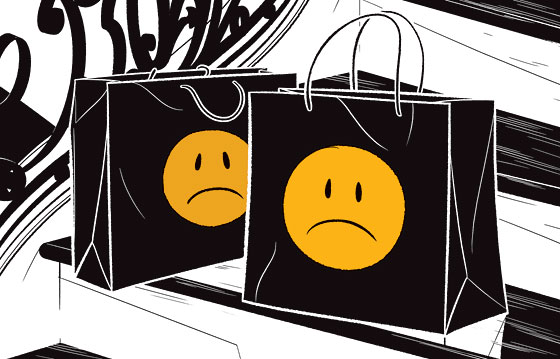
Last Monday, a Craigslist post went up calling upon Kim Kardashian fans to hold a vigil for their idol’s marriage, which had given up the ghost hours earlier. It was very likely a prank, a bid to create viral content by a website specializing in the same, but the gathering’s location—Kardashian’s Dash store at Spring and Greene Streets in Soho—meant it also functioned as an occasion for deeper social commentary. Spring and Greene, you see, is just one block from Soho’s Apple store, ground zero for the massive, and absolutely earnest, public requiem for Steve Jobs. The mourners who brought their flowers, hand-drawn cards, and apples (with one bite carefully taken) to Mac outlets in the weeks after Jobs’s death weren’t the first to take their grief retail; when Alexander McQueen killed himself in 2010, his boutique on West 14th Street turned into a makeshift shrine. But this is a new phenomenon we’re witnessing. Exactly what happened to our collective psyche that it has added stores, places devoted to no other purpose than selling you stuff, to the list of venues for displaying public emotion?
The willingness to emote in public is, of course, as old as society itself. But technology has reduced the lag between the precipitating event and the expressions of loss to almost nil, while also making it possible to experience the jolt of communal feeling from the comfort of your couch. It felt like the whole world was there at Buckingham Palace after Princess Diana’s death, and 9/11, for all its horrors, had a hidden ecstatic lining in the fleeting mental sync-up that followed it. Today, Facebook and Twitter bring that kind of communion under lesser pretexts (Michael Jackson’s passing was perhaps the first fully social-networked Death Event). But they don’t provide the larger connection; for the full fix, it’s necessary to share the moment in the real world. A smattering of Post-its on a shop window is more affecting than the same sentiments expressed on a Facebook wall.
Still: When Thomas Edison died, thousands of mourners streamed by the casket at his West Orange laboratory, but it’s hard to imagine them massing outside phonograph shops. In Russia, Apple fans took their flowers and notes to the U.S. Embassy in Moscow: For them, Jobs was as much an American icon as a gadget-peddling one. The image of a store as a place of mourning fits neatly with the classic knock against America—that shopping is our true religion. But the reality is far less damning than that, I think. Over the last decade or so, we have simply made peace with the commercial side of artistry and accepted that commerce itself can be a form of self-expression. We no longer reflexively get our fur up when a band licenses a song for a TV ad or when a painter collaborates with a clothier. Flowers heaped outside a fashion boutique hawking the spring-summer collection may look morbid and odd, but hey, so was McQueen; he would have probably enjoyed the visual.
No one did more to conflate creativity and business than Steve Jobs, the man who held the patent for the glass staircases in some of his stores. In that sense, an Apple store is a natural proxy for the man and his legacy—as legitimate as a childhood home or even a gravestone. The lines grow even blurrier in the commerce of reality stardom, where the person is the product. Which makes posting “Stay Strong, Kim” on the window of Dash no more, and no less, of a joke than Kim Kardashian herself.
Have good intel? Send tips to intel@nymag.com.